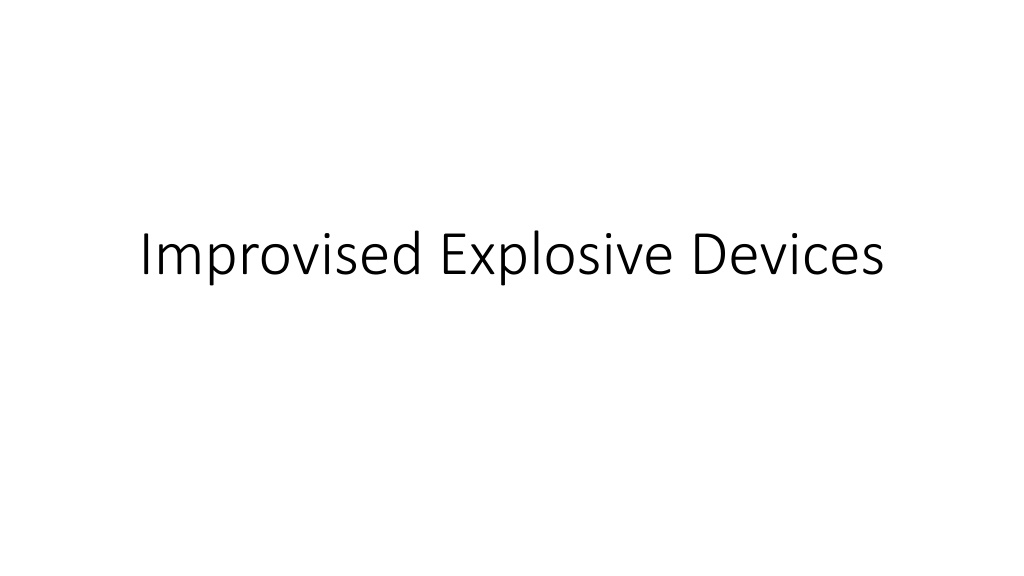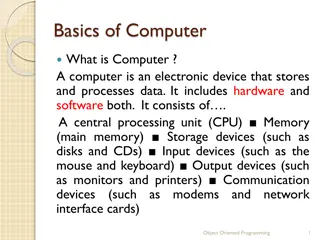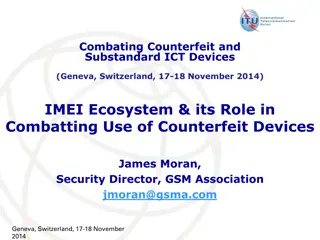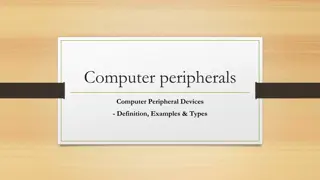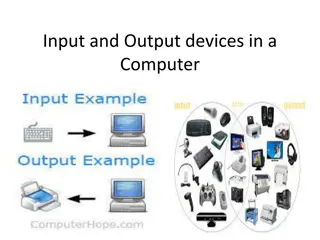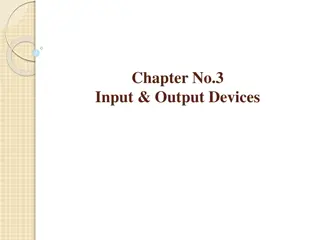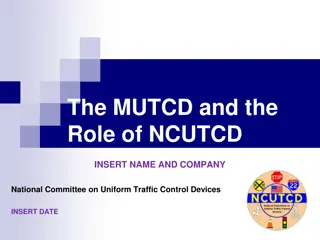Understanding Improvised Explosive Devices (IEDs)
Improvised Explosive Devices (IEDs) are dangerous bombs that can be of various shapes and sizes, operated electrically or mechanically. IEDs are designed to explode through handling, delay mechanisms, ambient conditions, or remote control. They consist of components like explosive, detonators, power sources, and switches. The aim of designing an IED is typically to instill panic, cause harm, or create extensive damage to public or private property. Various types of IEDs are disguised as everyday items like briefcases, gift packets, perfume bottles, and more.
Download Presentation

Please find below an Image/Link to download the presentation.
The content on the website is provided AS IS for your information and personal use only. It may not be sold, licensed, or shared on other websites without obtaining consent from the author. Download presentation by click this link. If you encounter any issues during the download, it is possible that the publisher has removed the file from their server.
E N D
Presentation Transcript
What is an IED Today bombs are popularly known as Improvised explosive devices. Then how is it different ??? It could be in any shape and size May be operated electrically or mechanically Designed to explode while handling or by use of delay mechanism or ambient condition or By remote control devices
Component of IED or bomb mechanism An standard IED or bomb mechanism consists of Explosive Detonators Power Sources Switches
EXPLOSIVE TRAIN FLAME PRODUCER FLAME CARRIER CONVERTING FLAME INTO DETONATION DETONATION WAVE CARRIER BOOSTER MAIN CHARGE
Power source + - Switch Detonator Explosive
Switches : Anti handling pressure pressure release pull tilt vibration mercury switches etc.
Switches : Delayed switch Mechanical - clock work, thermal chemical electrochemical Electronic
Ambient Condition smoke or gas. sound proximity Remote Control radio control wire control FM control
Clock work delay IED Circuit Clock Detonator Explosive Battery
Aim of designing of an IED designed, Manufactured by terrorist Planted with an aim of creating panic to General Public Kill VIPs cause extensive damage to Govt./ private property cause extensive damage to economic installations etc To hide any other crime
Types of IEDs Some of the IED s Brief-case Gift packet Perfume bottle Thermos flask Soap case Cigarette packet Ghee tin/Milk tin Letter and Book Telephone etc.
Petrol bomb Human bomb Jute bomb Car/scooter bomb Tiffin box bomb Soft drink can bomb Cycle bomb Television/radio bomb Aero model bomb etc.
The Explosive Act The INDIAN Explosive Act 1884 (Indian Word omitted w.e.f 2-3-1983) Explosive means gunpowder, nitroglycerine, nitroglycol, guncotton, DNT, TNT, picric acid, dinitrophenol, styphnic acid, RDX, PETN, tetryl, lead azide ect etc includes fire works, detonators, ammunition of all descriptions etc.
Explosive Substance Act 1908 (a) The expression Explosivesubstance include any materials for making any explosive substance, also any apparatus, machine, implement or material used, or intended to be used, or adapted for causing, or aiding in causing, any explosion in or with any explosive substances; also any part of any such apparatus, machine or implement. (b) The expression special category explosive substace includes TNT, RDX, PETN, HMX Tetryl, CE, PEK, or any combination thereof and remote control devices etc.
Delay mechanism Clock work delay Chemical delay Material fatigue Cigarette & Matchbox delay Electronic delay(8min 32sec to 194days 4 hour 20 min)
Ambient Condition Switches Gas/Smoke Sensitive Metal Sensitive X-Ray sensitive Light Sensors
Remote Control switches Radio Control Command Wire Infrared
Time bomb Detonator Electronic Watch 9V Battery Magnet Explosive substance (RDX) Timing is set using the alarm of the watch.
EXPLOSION SIGNATURES PERMANENT DISTORTION OF OBJECT a) Plastic deformation b) Dishing of metal plates c) Fractures FRAGMENT ATTACK DISPLACEMENT OF OBJECTS FLAME & HEAT MARK EFFECTS ON PRESSURE
INJURY TO PERSONS Blast pressure wave Fragments injury Burn injury
SEAT OF EXPLOSION IDENTIFICATION OF SEAT OF EXPLOSION
CRATER D3=16W D =METER,W=KG
PRIMARY FRAGMENTS CASING OF DEVICE MARKING PAINTS MATERIAL INITIATING MECHANISM FRAGMENT FRAGMENTS FROM SWITCHES FRAGMENTS FROM POWER SOURCES
High Low 1. Shattering 2. Detonation 3. Small diameter but wide diameter deeper crater 4. Small fragments 5. Cutting effect 6. Confinement Independent No shattering Deflagration bigger fragments bending effect Confinement dependent
DIFFERENCE BETWEEN LOW AND HIGH DIFFERENCE BETWEEN LOW AND HIGH EXPLOSIVE EXPLOSIVE LOW HIGH 1. 2. 3. 4. 5. LESS SHATTERING EFFECT WIDE DIAMETER CRATER GRADUAL SLOPING BIGGER FRAGMENTS INTENSE HEAT EFFECT, LITTLE OR MODERATE BLAST EFFECT DEPENDENT ON CONFINEMENT BENDING EFFECT 1. 2. MORE SHATTERING EFFECT SMALL DIAMETER BUT DEEPER SLOPE VERY STEEP SMALLER FRAGMENTS SEVERE BLAST EFFECT INDEPENDENT OF CONFINEMENT CUTTING EFFECT 3. 4. 5. 6. 6. 7. 7.
FREQUENTLY ASKED QUESTIONS WHAT KIND OF EXPLOSIVE HOW MUCH EXPLOSIVES ARE USED WHAT COULD BE THE TRIGGERING MECHANISM
POST EXPLOSION ANALYSIS EXTRACTION CHEMICAL TEST INSTRUMENTAL ANALYSIS THIN LAYER CHROMATOGRAPHY HIGH PERFORMANCE THIN LAYER CHROMATOGRAPHY H.P.L.C. I.R. G.C. G.C. MASS I.C.
Don'ts 1. Do not touch or remove packet unless duty bound. 2. Do not open the package with hands. 3. Do not puncture the package. . 4. Do not submerge the package In water. 5. Do not cut or pullout the strings or wire. 6. Do not pass the metallic object over the package. 7.Do not accept the identification marks on the package on the face value. 8.Do not bring a bomb or suspected object in police station or security control room. 9.Do not use radio in the vicinity of bomb.
10. 10. Do not transport the suspected object through congested area. 11. 11.Do not transport the suspected object . Do not transport the suspected object . 11. 12.Evacuate the people to safe distance. Always evacuate the people and NOT the BOMB. 12. 13.Do not direct a flash light on the bomb. 13. 14.Do not cover the object. 14. 15.Do not permit re-entry of people until objects are removed. 15. 16.Do not be a DEAD HERO. You can construct a building or house but you can not make dead man alive.
Dos 1. Do evacuate men immediately to a safe distance. 2. 3. 4. 5. 6. Open all windows and doors. Place sand bags around the suspected object. Inform Bomb Disposal Squad. Inform Fire Brigade, Hospital and Ambulance. Do handle the package alone if you are duty bound to handle. 7. Remove all inflammable items.
Dos Actions before bomb call 1. Selection/nomination of persons 2. Training 3. Equip them 4. Prepare contingency plan 5. Prepare search plan 6. Prepare evacuation plan 7. Educate officers and staff on telephone threats 8. Rehearsals
Golden rules of Handling Use rubber gloves- Do not touch anything with bare hands Avoid the temptation of picking up an article immediately on seeing it. Carefully examine the article externally before touching it and then handle it accordingly. After the preliminary examination (before touching the article) make a record in writing of the exact spot where it was found. Handling should be as minimum as possible and should be done in such a way as to leave the article as nearly as possible in its original condition.
Handling should be a little bit abnormal, i.e., hold the article only by such parts as are unlikely to have been touched by the previous users whose finger impressions may be on them Use forceps to pick up a small article Main attention to be paid to see that your handling should not disturb or obliterate any trace which may subsequently prove to be of great importance.
Packing and Labeling 1.Each article should be separately packed and labeled indicating the serial number of the item. 2.Two or more items should never be packed together. 3.The labels should numbered consecutively and should bear the signature of the forwarding officer and the case number and date of his letter of advice . 4 So far as possible , all such packets belonging to one case should be enclosed one box or outer covering to for a parcel. 5.Packets of articles belonging to different cases should never be enclosed in one parcel. 6.Soil and other stiff loose materials are best stored in plastic bag or metallic container. 7. Sharp edged objects should not be allowed to pierce the sides of the plastic bag. 8. Pack the initiating device or the detonators separately with cotton wrapping.
Sealing All parcels should be carefully sealed by the despatching officers and packed in such a manner that they cannot be opened without destroying the seals. In one case, the same seal should be used throughout. The specimen seal should be the same with the seals of the packets.
Forwarding A letter of advice should be separately forwarded to the examiner concerned. Forwarding letter should contain the following particulars: a) report number b) case reference c) brief history of the case d) description of articles in each packet e) Nature of examination required f) forwarding note of the officer through whom the articles are forwarded g) name of the investigating officer h) specimen seal used on the parcel i) certificate of authority to examine
Chain of custody The continuity or chain of custody of the exhibits must be insured in order to maintain its integrity. there should be record of the names of the persons through whom the exhibits passed and to whom they were delivered together with the time and date
